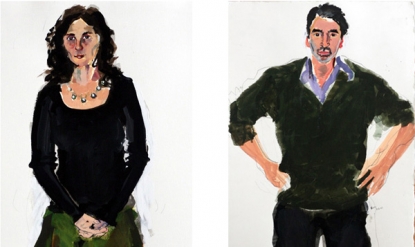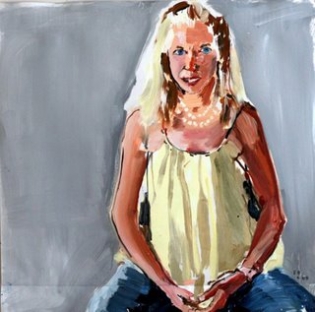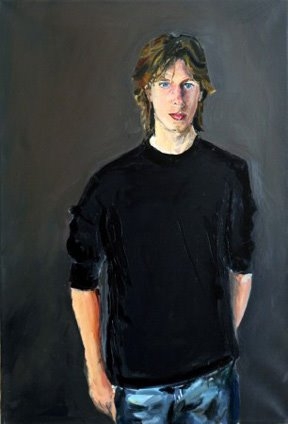
Generation Sketch (Charity,) left, (2007), watercolor on paper, 39 ½ x 22 inches, and Generation Sketch (Dan,) right, (2007), Frank Born, watercolor on paper, 44 x 22 inches. Photos by Chester Hu, courtesy of the artist
Feature: Reviews
Frank Born: Generation
- Cabrillo Gallery
- Aptos, CA
- April 25-May 31, 2008
I recently attended an exhibition that was a powerful antidote to the many isolating, dehumanizing forces in our lives. Frank Born, a San Francisco artist, exhibited a selection of his portraits at the Cabrillo Gallery in Aptos. These paintings express and explore relationships—the almost invisible connections that define our humanity. More than a particular person at a point in time, the portraits convey perceptible, unique interactions between the artist, the paint, and the person portrayed. Additionally, this particular collection of Born’s portraits makes visible the dimensions of time—momentary, extended, isolated, or shared—in relationships, in painting, and even in our world. The relationships and dimensions thus captured reveal respect, curiosity, and intensity. They invite the viewer to journey into their warm intimacy as well.
As I made my way around the exhibit, I found myself substituting the word “painting” for the word “poetry” in the famous Marianne Moore poem, “Poetry”:
. . .if you demand on the one hand
the raw material of [painting] in
all its rawness and
that which is on the other hand
genuine. . . .
Born does not flatter; he is a humanist who seems to revere equally his subject and his medium, conjoining them with honesty, thoughtfulness, and immediacy. Born’s artistic observations, sometimes apparent in a quick brushstroke or patch of color, often intimate subtleties of character as well as the intense collaborative enterprise of portraiture.
A portrait of Susan gives an idea of the complexity of such relationships in the paintings. Here, the unusual combination of materials suggests the role Born’s response to the sitter’s character may play in his artistic choices. The technique—quick, translucent brushstrokes with areas left unpainted—speaks of watercolors, air, summer, and a young woman ready to take flight into the world, into her life. Areas of silver unpainted paper add a glimmer of excitement. On the other hand, the substance of the oil paint counters the lightness of the brushwork with permanence and depth. The trust and openness of the relationship between the painter and the woman being painted is evident; more than pretty, her portrait is vibrant and candid; her unique character, through Born’s translation into art, is their mutual gift to the viewer
A number of portraits in the exhibit follow the development of children into young adulthood. In these, we see both the evanescence of childhood and the essence of the particular child, even in young people. Jacob Berman projects a thoughtful, grave presence. A meticulously worked and lushly polished painting, it honors an evidently idealistic and sensitive young man. The portrait is respectful, serious, and truthful, yet conveys Born’s optimism for this younger generation. Jacob, in this rendering, seems to have understood the importance of the human and artistic transaction involved in being portrayed; indeed, he seems worthy of the trust placed in him. This coming-of-age portrait is an eloquent and elegant statement of promise, both of human potential and of the artistic power to show it.
Just as Born’s paintings present youth with integrity, they also approach age with a sense of dignity. One of the earliest paintings in the exhibit, Frank Bluestein, acknowledges the weight of time in the gentle slump of the pose, the slight skewing of the head, and the cast of the shadow on the sitter. The eyes are tired but the gaze is direct, and we sense deep affection in its trust. The rich simplicity in the rendering of the garments contrasts the nuanced complexity of skin, in which we see the hues and pallors of age and of having lived. Without sentimentality, the portrait gives us deep sentiment.
The title of the exhibition refers to a work in progress not included in the show, watercolor studies for which occupied one whole wall of the gallery (see top of page). By sharing Generation –especially at this stage in its creation—Born multiplied many times over the kinds of relationships his art explores, as viewers in the gallery became privy to his creative process. In its present unfinished form, which I have seen since the Cabrillo exhibition, Generation is an enormous canvas, about 40 feet long, with nine nearly life-sized figures painted in oil. Each figure stands alone but also forms a panoramic vision of an entire generation, heroic in its conception. The figures are the people closest to Frank Born and can also be seen to represent the people all of us over 50 have known all our lives. They are us, and we recognize our strengths and frailties, our attitudes, our successes and failures, and our beliefs. Born has lovingly and accurately documented their lives and thus shows us their value, and ours. Their private meanings, collectively portrayed, become many of our public ones. On the wall of the gallery, the studies of these people reached out powerfully. They were “the raw material of [painting,] in all its rawness,” but they were breathtaking—alive and genuine.
Watch for Generation in its completed form. You just might feel connected.


